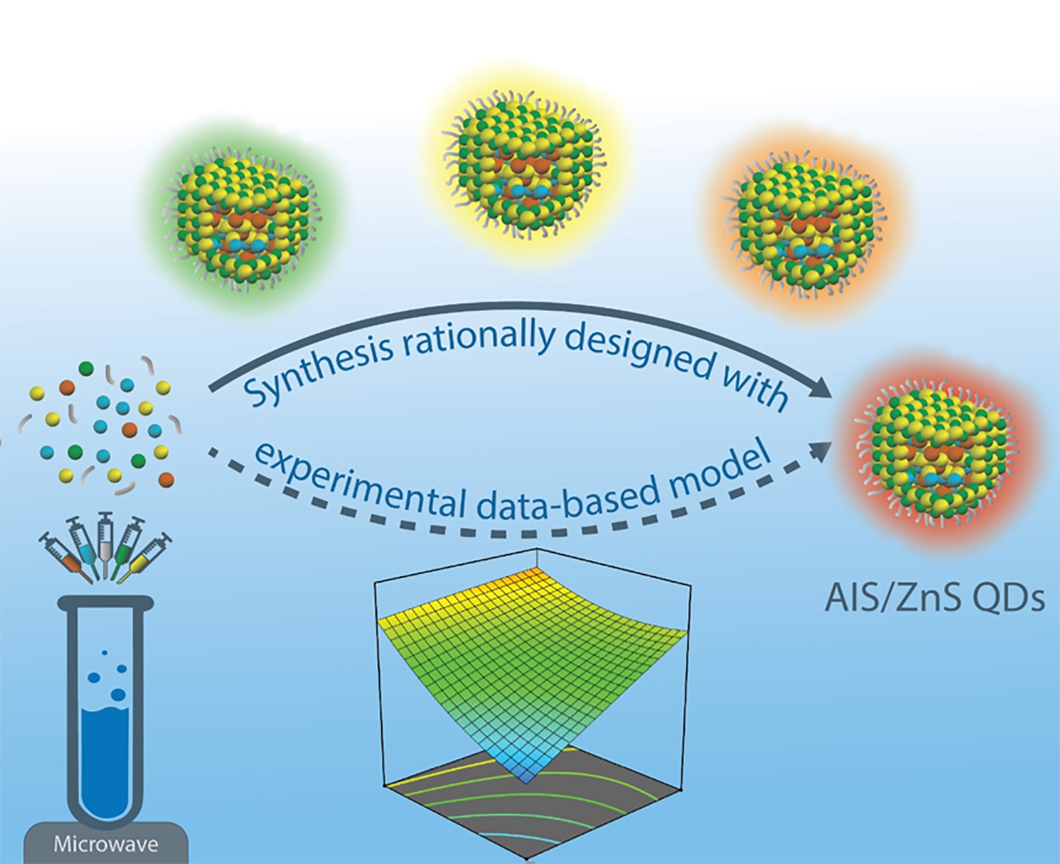
Microwave-based synthesis of AgInS2/ZnS quantum dots (AIS/ZnS QDs) using optimised synthesis parameters provided by the Design of Experiment (DoE) approach
Source: BAM, Biophotonics division
Quantum dots (QDs) made from e.g., IV/VI, III/V, and IV/VI semiconductor are nanomaterials with size-tunable absorption and photoluminescence (PL) properties in the visible, near infrared, and short-wave infrared (SWIR) wavelength region, which have created tremendous interest and research in the last decades. These nanomaterials have meanwhile found applications e.g., in displays and solar cells, as converter materials for light emitting diodes, laser materials, and as optical reporters for fluorescence assays, bioimaging, and sensors. The translation of QD technology to commercial applications in the life and material sciences is partly hampered by the presence of potentially toxic constituents such as cadmium or lead. This triggered the search for QDs made from less toxic constituents by environmentally friendly “greener” syntheses. Interesting alternatives are cadmium-free AgInS2/ZnS (AIS/ZnS) QDs, that can be prepared in water in high quality and reveal high PL efficiencies (PL quantum yields, PL QY). Also, they have relatively long PL lifetimes of up to several hundreds of nanoseconds, which can be exploited for time-gated emission.
The rational design of AIS/ZnS QDs with precise control of their PL properties requires methods that can predict PL performance parameters like the spectral position of the PL maximum, size of PL QY, and PL lifetime. We used a design-of-experiment (DoE) approach for the microwave-assisted synthesis of AIS/ZnS QDs capped with mercaptopropionic acid (MPA) and optimized parameters involved in QD formation like the reaction time, temperature, Ag:In ratio, S:In ratio, Zn:In ratio, MPA:In ratio, and pH to obtain optimum PL features. In this DoE approach, experimental data-based mathematical models were developed for QD composition, in terms of Ag:In:Zn content, and for the PL parameters PL maximum, PL QY, and PL lifetime. Thereby, a relationship between the reaction conditions, composition of the AIS/ZnS QDs, and their application-relevant PL parameters was established as a basis to predict the conditions for the synthesis of AIS/ZnS QDs with precisely designed PL parameters. The reliability of our methodology was confirmed by the excellent agreement between the predicted and experimentally found PL features. This methodology, which also provided a deeper insight into the complex structure and properties of AIS/ZnS QDs, can be expanded to other types of functional nanomaterials.
Rationally designed synthesis of bright AgInS2/ZnS quantum dots with emission control
José X. Soares, K. David Wegner, David S. M. Ribeiro, Armindo Melo, Ines Häusler, João L. M. Santos & Ute Resch-Genger
published in Nano Research, Vol. 13, pages 2438–2450, 2020 (open access)
BAM Biophotonics division


